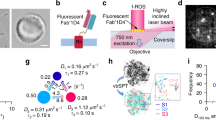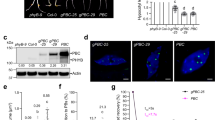Abstract
In Drosophila photoreceptors, phospholipase C (PLC) and other signalling components form multiprotein structures through the PDZ scaffold protein INAD. Association between PLC and INAD is important for termination of responses to light; the underlying mechanism is, however, unclear. Here we report that the maintenance of large amounts of PLC in the signalling membranes by association with INAD facilitates response termination, and show that PLC functions as a GTPase-activating protein (GAP). The inactivation of the G protein by its target, the PLC, is crucial for reliable production of single-photon responses and for the high temporal and intensity resolution of the response to light.
This is a preview of subscription content, access via your institution
Access options
Subscribe to this journal
Receive 12 print issues and online access
$209.00 per year
only $17.42 per issue
Buy this article
- Purchase on Springer Link
- Instant access to full article PDF
Prices may be subject to local taxes which are calculated during checkout






Similar content being viewed by others
References
Songyang, Z. et al. Recognition of unique carboxyl-terminal motifs by distinct PDZ domains. Science 275, 73– 77 (1997).
Devary, O. et al. Coupling of photoexcited rhodopsin to inositol phospholipid hydrolysis in fly photoreceptors. Proc. Natl. Acad. Sci. USA 84 , 6939–6943 (1987).
Lee, Y. J., Dobbs, M. B., Verardi, M. L. & Hyde, D. R. dgq: a Drosophila gene encoding a visual system-specific G α-molecule . Neuron 5, 889–898 (1990).
Scott, K., Becker, A., Sun, Y., Hardy, R. & Zuker, C. Gq α-protein function in vivo: genetic dissection of its role in photoreceptor cell physiology. Neuron 15, 919–927 (1995).
Bloomquist, B. T., et al. Isolation of a putative phospholipase C gene of Drosophila , norpA, and its role in phototransduction. Cell 54, 723–733 (1988).
Selinger, Z. & Minke, B. Inositol lipid cascade of vision studied in mutant flies. Cold Spring Harb. Symp. Quant. Biol. 53 Pt 1, 333–341 (1988).
Huber, A., Sander, P., Gobert, A., Bahner, M., Hermann, R. & Paulsen, R. The transient receptor potential protein (Trp), a putative store- operated Ca2+ channel essential for phosphoinositide-mediated photoreception, forms a signaling complex with NorpA, InaC and InaD. EMBO J. 15, 7036–7045 (1996).
Shieh, B. H. & Zhu, M. Y. Regulation of the TRP Ca2+ channel by INAD in Drosophila photoreceptors. Neuron 16, 991–998 ( 1996).
Shieh, B. H., Zhu, M. Y., Lee, J. K., Kelly, I. M. & Bahiraei, F. Association of INAD with NORPA is essential for controlled activation and deactivation of Drosophila phototransduction in vivo . Proc. Natl Acad. Sci. USA 94, 12682 –12687 (1997).
Chevesich, J., Kreuz, A. J. & Montell, C. Requirement for the PDZ domain protein, INAD, for localization of the TRP store-operated channel to a signaling complex. Neuron 18, 95–105 (1997).
Tsunoda, S. et al. A multivalent PDZ-domain protein assembles signalling complexes in a G-protein-coupled cascade. Nature 388, 243–249 (1997).
van Huizen, R. et al. Two distantly positioned PDZ domains mediate multivalent INAD-phospholipase C interactions essential for G protein-coupled signaling. EMBO J. 17, 2285–2297 (1998).
Xu, X. Z., Choudhury, A., Li, X. & Montell, C. Coordination of an array of signaling proteins through homo- and heteromeric interactions between PDZ domains and target proteins. J. Cell Biol. 142, 545–555 (1998).
Berridge, M. J. & Irvine, R. F. Inositol trisphosphate, a novel s messenger in cellular signal transduction. Nature 312, 315–321 (1984).
Berstein, G., Blank, J. L., Jhon, D. Y., Exton, J. H., Rhee, S. G. & Ross, E. M. Phospholipase C-β 1 is a GTPase-activating protein for Gq/11, its physiologic regulator. Cell 70, 411–418 (1992).
Mukhopadhyay, S. & Ross, E. M. Rapid GTP binding and hydrolysis by G(q) promoted by receptor and GTPase-activating proteins . Proc. Natl. Acad. Sci. USA 96, 9539– 9544 (1999).
Arshavsky, V. Y. & Pugh, E. N. Lifetime regulation of G protein-effector complex: emerging importance of RGS proteins. Neuron 20, 11–14 (1998).
Makino, E. R., Handy, J. W., Li, T. & Arshavsky, V. Y. The GTPase activating factor for transducin in rod photoreceptors is the complex between RGS 9 and type 5 G protein β subunit. Proc. Natl Acad. Sci. USA 96, 1947–1952 (1999).
Chen, C.-K., Burns, M. E., He, W., Wensel, T. G., Baylor, D. A. & Simon, M. I. Slowed recovery of rod photoresponse in mice lacking the GTPase accelerating protein RGS 9-1. Nature 403, 557– 560 (2000).
Baylor, D. A., Lamb, T. D. & Yau, K. W. Responses of retinal rods to single photons. J. Physiol. Lond. 288, 613–634 (1979).
Yeandle, S. & Spiegler, J. B. Light-evoked and spontaneous discrete waves in the ventral nerve photoreceptor of Limulus. J. Gen. Physiol. 61, 552–571 (1973).
Dodge, F. A., Jr, Knight, B. W. & Toyoda, J. Voltage noise in Limulus visual cells. Science 160, 88–90 (1968).
Wu, C. F. & Pak, W. L. Light-induced voltage noise in the photoreceptor of Drosophila melanogaster. J. Gen. Physiol. 71, 249–268 ( 1978).
Berridge, M. J. Capacitive calcium entry. Biochem. J. 312, 1–11 (1995).
Yau, K. W. & Baylor, D. A. Cyclic GMP-activated conductance of retinal photoreceptor cells. Annu. Rev. Neurosci. 12, 289–327 (1989).
Stieve, H. Bumps, the elementary excitatory responses of invertebrates. in The Molecular Mechanism of Photoreception (ed. Stieve,H.) 199-230 (Springer Verlag, Berlin, 1986).
Kirkwood, A., Weiner, D. & Lisman, J. E. An estimate of the number of G regulator proteins activated per excited rhodopsin in living Limulus ventral photoreceptors . Proc. Natl. Acad. Sci. USA 86, 3872– 3876 (1989).
Fein, A., Payne, R., Corson, D. W., Berridge, M. J. & Irvine, R. F. Photoreceptor excitation and adaptation by inositol 1,4,5-trisphosphate. Nature 311, 157– 160 (1984).
Minke, B. & Stephenson, R. S. The characteristics of chemically induced noise in Musca photoreceptors. J. Comp. Physiol. 156, 339–356 (1985).
Pak, W. L., Ostroy, S. E., Deland, M. C. & Wu, C. F. Photoreceptor mutant of Drosophia: is protein involved in intermediate steps of phototransduction? Science 194, 956–959 (1976).
Scott, K. & Zuker, C. S. Assembly of the Drosophila phototransduction cascade into a signalling complex shapes elementary responses . Nature 395, 805–808 (1998).
Pearn, M. T., Randall, L. L., Shortridge, R. D., Burg, M. G. & Pak, W. L. Molecular, biochemical, and electrophysiological characterization of Drosophila norpA mutants. J. Biol. Chem. 271, 4937–4945 (1996).
Meij, J. T. & Ross, E. M. Purification and characterization of phospholipase C-β 1 mutants expressed in E. coli. Biochem. Biophys. Res. Commun. 225, 705– 711 (1996).
Pak, W. L. in Neurogenetics: Genetic Approaches to the Nervous System (ed. Breakfield,X.) 67–99 (Elsevier North-Holland, New York, 1979).
Hardie, R. C. & Minke, B. The trp gene is essential for a light-activated Ca2+channel in Drosophila photoreceptors . Neuron 8, 643–651 (1992).
Baylor, D. How photons start vision. Proc. Natl Acad. Sci. USA 93, 560–565 (1996).
He, W., Cowan, C. W. & Wensel, T. G. RGS 9, a GTPase accelerator for phototransduction . Neuron 20, 95–102 (1998).
Tsang, S. H. et al. Role for the target enzyme in deactivation of photoreceptor G protein in vivo. Science 282, 117– 121 (1998).
Hardie, R. C., Peretz, A., Pollock, J.A. & Minke, B. Ca2+ limits the development of the light response in Drosophila photoreceptors. Proc. Roy. Soc. Lond. B 252, 223–229 (1993).
Hardie, R. C. Whole-cell recordings of the light induced current in dissociated Drosophila photoreceptors: evidence for feedback by calcium permeating the light-sensitive channels. Proc. Roy. Soc. Lond. B 245, 203 –210 (1991).
Peretz, A., Suss-Toby, E., Rom-Glas, A., Arnon, A., Payne, R. & Minke, B. The light response of Drosophila photoreceptors is accompanied by an increase in cellular calcium: effects of specifics mutations . Neuron 12, 1257–1267 (1994).
Blumenfeld, A., Erusalimsky, J., Heichal, O., Selinger, Z. & Minke, B. Light-activated guanosinetriphosphatase in Musca eye membranes resembles the prolonged depolarizing afterpotential in photoreceptor cells. Proc. Natl Acad. Sci. USA 82 , 7116–7120 (1985).
Minke, B. & Selinger, Z. in Progress in Retinal Research (eds Osborne,N.A. & Chader,G.J.) 99-124 (Pergamon Press, Oxford, 1991).
Schramm, M. (ed. Martonosi, N. A.) in Membranes and Transport (ed. Martonosi, N. A.) 555–560 (Plenum, New York, 1982).
Acknowledgements
We thank. R. D. Shortridge for the anti NORPA antibodies, the T 6 mutant and the norpA+ gene and B.-H. Shieh for discussions and for the norpAC1094S mutant, W. L. Pak and C. S. Zuker for the norpA, Gαq 1 and inaD mutants respectively. We also thank H. Cedar, A. Shalom, M. Treinin and M. Danin for critical reading of the manuscript. The work was supported by grants from the NIH, (EY-03529 to B.M. and Z.S.), the US-Israel Binational Science Foundation (B.M., Z.S. and Z.P.), the Israel Science Foundation (to B.M. Z.S. and Z.P.), the Israel Cancer Fund (Z.P.), the German Israeli Foundation (B.M.) and the Minerva Foundation.
Correspondence and requests for materials should be addressed to B.M.
Author information
Authors and Affiliations
Corresponding author
Rights and permissions
About this article
Cite this article
Cook, B., Bar-Yaacov, M., Cohen Ben-Ami, H. et al. Phospholipase C and termination of G-protein-mediated signalling in vivo. Nat Cell Biol 2, 296–301 (2000). https://doi.org/10.1038/35010571
Received:
Revised:
Accepted:
Published:
Issue Date:
DOI: https://doi.org/10.1038/35010571
This article is cited by
-
Molecular determinants of response kinetics of mouse M1 intrinsically-photosensitive retinal ganglion cells
Scientific Reports (2021)
-
Structural design principles that underlie the multi-specific interactions of Gαq with dissimilar partners
Scientific Reports (2019)
-
Phototransduction in Drosophila
Science China Life Sciences (2012)
-
Prolonged Gq activity triggers fly rhodopsin endocytosis and degradation, and reduces photoreceptor sensitivity
The EMBO Journal (2007)
-
Phototransduction and retinal degeneration in Drosophila
Pflügers Archiv - European Journal of Physiology (2007)



